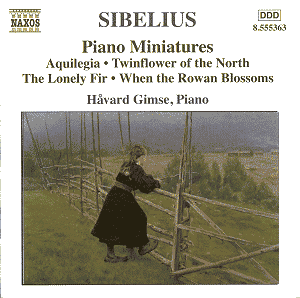Revered for his symphonies, tone poems, and
orchestral songs, the piano music of Jean Sibelius gets little
recognition except for the occasional recording. Prevailing opinion
is that his piano works are not idiomatic of the instrument and
possess only a small amount of the inspiration that went into
his orchestral compositions. After all, Sibelius only wrote for
solo piano to pay the bills. His primary focus was on larger scale
works.
I find his piano music to exhibit a wide range
of quality and inspiration. The lesser pieces give off a flavor
of medicore and repetitive salon music, but his best pieces are
quite compelling, interesting and memorable. What canít be discovered
in the Sibelius miniatures is a wealth of diversity packed into
two minutes of music. Bach or Chopin routinely would offer up
miniatures with such breadth of themes and construction that each
constituted an entire world. A Sibelius miniature provides only
a tiny slice of life.
The disc at hand is Volume 4 of Håvard
Gimseís traversal of the Sibelius solo piano works. Gimse, born
in 1966, has won a number of piano competitions and played with
the major orchestras of Europe. His discography includes the music
of Grieg, Martinů, Mozart and
Tveitt. In addition to recording for Naxos, Gimse has been associated
with Intim, Simax, Virgin Classics and Chandos.
Gimse delivers very attractive readings that
are warm, poetic and user-friendly. Actually, you wonít find more
affectionate performances on disc. There is a trade-off in his
approach in that the interpretations could be more exuberant and
also more cognizant of the occasional modernist appeal of the
music.
Gimse opens Volume 4 with the "Four Lyric
Pieces" which have little in their favor other than their
lyricism. Each has an attractive primary theme, but development
is thin and entails much repetition. Further, attempts at additional
themes are largely unsuccessful and carry excessive baggage from
the primary theme. It adds up to rather drab listening.
Fortunately, there is nothing drab about the
"Five Pieces" Op.75, a homage to five different varieties
of trees. These are absolute gems that retain my attention after
many hearings. Although not displaying any significant contrast,
each piece is expertly constructed with engrossing melodies and
rhythms that are not soon forgotten. "When the rowan blossoms"
is exquisite music of a melancholy and questioning nature that
sparkles throughout. "Aspen" has a child-like innocence
wrapped in mystery, and "The Birch" is an exuberant
piece still retaining an element of the unknown. My favorite of
the set is "The Spruce" with its contrasting waltz rhythms
and suspensions.
I think highly of the Opus 75 performances by
Marita Viitasalo on a Finlandia disc. In contrast to Gimse, she
highlights the harmonic twists in "When the rowan blossoms",
making the piece more interesting. Generally, her articulation
is cleaner than Gimseís as well. However, she is cooler and a
little distant from the music.
The "Thirteen Pieces" of Opus 76 are
shorter in length than for Opus 75, and issues of diversity become
moot. With little exception, these pieces are among Sibeliusís
most enjoyable. They flow beautifully and express human urges,
regret and triumph. Sibelius also injects a delightful improvisation
into a few of the works.
Comparing the Opus 76 performances of Gimse to
Mustonen is illuminating. Gimse continues to offer excellent readings
with an enticing blend of warmth and mystery. Mustonen brings
this music to life with tremendous projection, exacting detail
and an incisive virility and exuberance. Though there might be
some merit in the view that Mustonenís readings are Ďlarger than
lifeí, I am smitten with them. Ultimately, I think it is fair
to say that Mustonen gives us a Sibelius who opens his heart for
public consumption, while Gimseís Sibelius wants to entice us
with the mystery of life.
The Op. 85 pieces are a good example of the variable
quality of Sibeliusís piano music. Three of the pieces sparkle
with delight, but the modest musical material that Sibelius brings
to "Iris" cannot support its three minute length. The
last piece, "Campanula", is overly repetitive with an
impressionistic doodling that ventures nowhere. Regardless of
the musicís quality, each piece cries out for warmth that is a
feature playing into Gimseís strengths. Viitasaloís cooler interpretations
of these floral miniatures gives them the kiss of impending winter.
Gimse concludes his program with the Op. 94 pieces.
Except for "Danse" which is an invigorating waltz, most
of the setís music tends to be either maudlin or lounge-type in
nature.
In summary, recordings of the Sibelius piano
miniatures have a low priority in relationship to his orchestral
works. Some of the pieces transcend the mundane. It is clear that
Sibelius had utilitarian reasons for composing this music. Piano
enthusiasts would likely derive more pleasure from the listening
experience than Sibelius fans, because his piano music bears little
resemblance to his more popular compositions.
For those who remain interested in Sibelius piano
discs, Gimseís Naxos series is a fine choice. The price tag is
low, and he offers affectionate interpretations in rich and clear
sound. My best advice is to gravitate toward Mustonen who lifts
the piano music of Sibelius to a higher plane.
Don Satz
See also review
by Christopher Howell



![]() Håvard Gimse, piano
Håvard Gimse, piano
![]() NAXOS 8.555363 [62:11]
NAXOS 8.555363 [62:11]